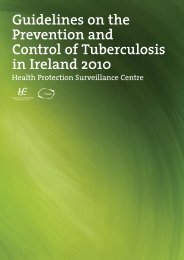Guidelines for the Early Clinical and Public Health Management of ...
Guidelines for the Early Clinical and Public Health Management of ...
Guidelines for the Early Clinical and Public Health Management of ...
Create successful ePaper yourself
Turn your PDF publications into a flip-book with our unique Google optimized e-Paper software.
<strong>Guidelines</strong> <strong>for</strong> <strong>the</strong> <strong>Early</strong> <strong>Clinical</strong> <strong>and</strong> <strong>Public</strong> <strong>Health</strong> <strong>Management</strong> <strong>of</strong> Bacterial Meningitis (including Meningococcal Disease)<br />
Table 10.1 Infection control precautions recommended <strong>for</strong> meningococcal cases in clinical settings<br />
Requirement<br />
Gloves<br />
Impermeable apron/gown<br />
Mask<br />
Goggles/face-shield<br />
Patient in single room<br />
Negative pressure<br />
Transport <strong>of</strong> patients<br />
O<strong>the</strong>r<br />
Infection control team in<strong>for</strong>med<br />
Additional precautions <strong>for</strong> <strong>the</strong> first 24 hours <strong>of</strong><br />
appropriate systemic antibiotic treatment<br />
St<strong>and</strong>ard precautions<br />
St<strong>and</strong>ard precautions<br />
Surgical mask a<br />
Protect face if splash likely†<br />
Yes - door closed<br />
Not required<br />
Surgical mask a <strong>for</strong> patient<br />
Notify area receiving patient<br />
If single room unavailable provide a minimum<br />
one metre <strong>of</strong> separation between patients in ward<br />
accommodation<br />
St<strong>and</strong>ard precautions<br />
a<br />
Surgical mask refers to a fluid-repellent, paper filter mask used in surgical procedures.<br />
†Wear a mask (shield type) when carrying out close examination on a patient (e.g. when per<strong>for</strong>ming ophthalmic<br />
fundoscopy) especially if <strong>the</strong>y have coughing, sneezing, or if undertaking aerosol generating procedure (including<br />
examination <strong>of</strong> throat).<br />
10.3 Visitors <strong>of</strong> case<br />
Visitors within 1 metre <strong>of</strong> <strong>the</strong> case in <strong>the</strong> first 24 hours <strong>of</strong> antibiotic treatment should wear a surgical mask<br />
(precautions <strong>for</strong> droplet transmission). Thereafter, st<strong>and</strong>ard infection control measures apply. Visitors do not need to<br />
wear protective clothing unless <strong>the</strong>y are at risk <strong>of</strong> exposure to naso-pharyngeal secretions but should be instructed<br />
to decontaminate <strong>the</strong>ir h<strong>and</strong>s be<strong>for</strong>e <strong>and</strong> after visiting cases.<br />
10.4 Pathologists <strong>and</strong> anatomical pathology technicians<br />
Pathologists <strong>and</strong> pathology technicians who may be exposed to infected airborne droplets during <strong>the</strong> per<strong>for</strong>mance <strong>of</strong><br />
an autopsy should receive chemoprophylaxis when a mask has not been worn <strong>and</strong> when <strong>the</strong> deceased individual did<br />
not receive appropriate systemic antibiotics <strong>for</strong> a minimum <strong>of</strong> 24 hours prior to death.<br />
10.5 Relatives contact with body <strong>of</strong> deceased<br />
It is not necessary to restrict relatives viewing, touching, <strong>and</strong> kissing <strong>the</strong> body on infection control grounds. However,<br />
chemoprophylaxis <strong>and</strong> vaccination may be required if <strong>the</strong>se individuals were close contacts <strong>of</strong> <strong>the</strong> deceased prior to<br />
death (see Section 7.2 on chemoprophylaxis).<br />
10.6 H<strong>and</strong>ling <strong>and</strong> transport <strong>of</strong> deceased patients<br />
All bodies <strong>of</strong> deceased patients should be h<strong>and</strong>led using st<strong>and</strong>ard precautions. Body bags are not necessary <strong>and</strong><br />
transport to o<strong>the</strong>r countries <strong>for</strong> burial or cremation does not pose a risk. There is no restriction on embalming.<br />
10.7 Pre-exposure vaccination<br />
Staff h<strong>and</strong>ling or conducting research on N. meningitidis or staff working in higher risk settings such as <strong>the</strong> IMMRL or<br />
paediatric or infectious disease units where admissions related to meningococcal disease are frequent, may have a<br />
higher level <strong>of</strong> exposure that would justify vaccination.<br />
The need <strong>for</strong>, <strong>and</strong> timing <strong>of</strong>, a booster dose <strong>of</strong> a quadrivalent vaccine has not yet been determined.<br />
-78-

















